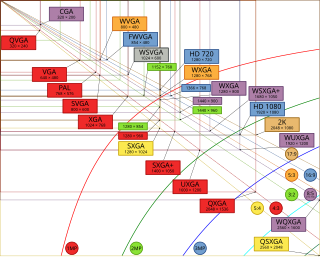
Video Graphics Array (VGA) is a graphics standard for video display controller first introduced with the IBM PS/2 line of computers in 1987, following CGA and EGA introduced in earlier IBM personal computers. Through widespread adoption, the term has also come to mean either an analog computer display standard, the 15-pin D-subminiature VGA connector, or the 640×480 resolution characteristic of the VGA hardware.

The Hercules Graphics Card (HGC) is a computer graphics controller made by Hercules Computer Technology, Inc. that combines IBM's text-only MDA display standard with a bitmapped graphics mode. This allows the HGC to offer both high-quality text and graphics from a single card. The HGC was very popular, and became a widely supported de facto display standard on IBM PC compatibles connected to a monochrome monitor. The HGC standard was used long after more technically capable systems had entered the market, especially on dual-monitor setups.

The Enhanced Graphics Adapter (EGA) is an IBM PC computer display standard from 1984 that superseded and exceeded the capabilities of the CGA standard introduced with the original IBM PC, and was itself superseded by the VGA standard in 1987.

Super Video Graphics Array or Ultra Video Graphics Array, almost always abbreviated to Super VGA, Ultra VGA or just SVGA or UVGA is a broad term that covers a wide range of computer display standards.

The Color Graphics Adapter (CGA), originally also called the Color/Graphics Adapter or IBM Color/Graphics Monitor Adapter, introduced in 1981, was IBM's first graphics card and first color display card for the IBM PC. For this reason, it also became that computer's first color computer display standard.
The Multi-Color Graphics Array or MCGA is a video subsystem built into the motherboard of the IBM PS/2 Model 30, introduced on April 2, 1987, and Model 25, introduced later on August 11; no standalone MCGA cards were ever made.

Text-based user interfaces (TUI), alternately terminal user interfaces, to reflect a dependence upon the properties of computer terminals and not just text, is a retronym parallel to the concept of graphical user interfaces (GUI). Like GUIs, they may use the entire screen area and accept mouse and other inputs. They may also use color and often structure the display using special graphical characters such as ┌ and ╣, referred to in Unicode as the "box drawing" set. The modern context of use is usually a terminal emulator.

The Monochrome Display Adapter is IBM's standard video display card and computer display standard for the PC introduced in 1981. The MDA does not have any pixel-addressable graphics modes. It has only a single monochrome text mode, which can display 80 columns by 25 lines of high resolution text characters or symbols useful for drawing forms.
Text mode is a computer display mode in which content is internally represented on a computer screen in terms of characters rather than individual pixels. Typically, the screen consists of a uniform rectangular grid of character cells, each of which contains one of the characters of a character set. Text mode is contrasted to all points addressable (APA) mode or other kinds of computer graphics modes.

The Windows Console is the Windows API-based infrastructure for text-based user interfaces and console applications in Microsoft Windows. An instance of a Windows Console has a screen buffer and an input buffer, and is available both as a window or in text mode screen, with switching back and forth available via Alt-Enter keys. The latter was not supported in Windows Vista, 7, 8, and 8.1, due to the system not supporting full-screen mode, but was made supported again in Windows 10.

The Plantronics Colorplus is a graphics card for IBM PC computers, first sold in 1982. It is a superset of the then-current CGA standard, using the same monitor standard and providing the same pixel resolutions. It was produced by Frederick Electronics, of Frederick, Maryland.

A video display controller or VDC is an integrated circuit which is the main component in a video signal generator, a device responsible for the production of a TV video signal in a computing or game system. Some VDCs also generate an audio signal, but that is not their main function.
In computing, indexed color is a technique to manage digital images' colors in a limited fashion, in order to save computer memory and file storage, while speeding up display refresh and file transfers. It is a form of vector quantization compression.

The Linux console is a system console internal to the Linux kernel. The Linux console provides a way for the kernel and other processes to send text output to the user, and to receive text input from the user. The user typically enters text with a computer keyboard and reads the output text on a computer monitor. The Linux kernel supports virtual consoles – consoles that are logically separate, but which access the same physical keyboard and display. The Linux console are implemented by the VT subsystem of the Linux kernel, and do not rely on any user space software. This is in contrast to a terminal emulator, which is a user space process that emulates a terminal, and is typically used in a graphical display environment.

Text-based semigraphics or pseudographics is a primitive method used in early text mode video hardware to emulate raster graphics without having to implement the logic for such a display mode.

Tandy Graphics Adapter is a computer display standard for an IBM PC compatible video subsystem that improved on IBM's Color Graphics Adapter (CGA) technology. Whereas CGA could display only four colors at a time at a screen resolution of 320×200 pixels, a TGA system could display up to 16 colors. While not strictly an adapter—the TGA hardware was available only integrated onto computer motherboards, not on a separate card—TGA is so called to parallel CGA, to which TGA is related and with which it competed.
















